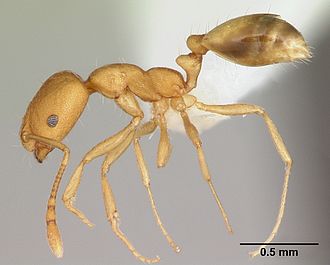Pharaoh ant

The pharaoh ant (Monomorium pharaonis) is a small (2 mm) yellow or light brown, almost transparent ant notorious for being a major indoor nuisance pest, especially in hospitals.[1] The pharaoh ant, whose origins are unknown, has now been introduced to virtually every area of the world, including Europe, the Americas, Australasia and Southeast Asia. It is a major pest in the United States, Australia, and Europe.[2][3]
This species is polygynous, meaning each colony contains many queens, leading to unique caste interactions and colony dynamics. This also allows the colony to fragment into bud colonies quickly.
Pharaoh ants are a tropical species, but they thrive in buildings almost anywhere, even in temperate regions provided central heating is present.
Pharaoh workers are about 1.5 to 2 millimeters long, a little more than 1/16-inch. They are light yellow to reddish brown in color with a darker abdomen. Pharaoh ant workers have a non-functional stinger used to generate pheromones.[4] The petiole (narrow waist between the thorax and abdomen) has two nodes and the thorax has no spines. Pharaoh ant eyesight is poor and they possess on average 32 ommatidia.[5] The antennal segments end in a distinct club with three progressively longer segments.
Males are about 3mm long, black, winged (but do not fly). Queens are dark red and 3.6–5mm long. They initially have wings that are lost soon after mating, but do not fly.[6]
The pharaoh ant queen can lay hundreds of eggs in her lifetime. Most lay 10 to 12 eggs per batch in the early days of egg production and only four to seven eggs per batch later. At 27 °C (80 °F) and 80 percent relative humidity, eggs hatch in five to seven days. The larval period is 18 to 19 days, pre-pupal period three days and pupal period nine days. About four more days are required to produce sexual female and male forms. From egg to sexual maturity, it takes the pharaoh ant about 38 to 45 days, depending on temperature and relative humidity. They breed continuously throughout the year in heated buildings and mating occurs in the nest. Mature colonies contain several queens, winged males, workers, eggs, larvae, pre-pupae and pupae.[3]
Each colony produces sexually reproductive individuals roughly twice a year. However, colonies raised in a laboratory can be manipulated to produce sexuals at any time of year. Colonies proliferate by “budding”[3] (also called “satelliting” or “fractionating”), where a subset of the colony including queens, workers and brood (eggs, larvae and pupae) leave the main colony for an alternative nest site.
Pharaoh ant colonies appear to prefer familiar nests to novel nests while budding. This suggests the ability for colonies to remember certain qualities of their living space. However, if the novel (unfamiliar) nest is of superior quality, the colony may initially move toward the familiar, but will eventually select the unfamiliar. The colony assumes the familiar nest is preferable, unless they sense better qualities in the novel nest. This decision-making process seeks to minimize the time the colony is without a nest while optimizing the nest the colony finally chooses.[7]
